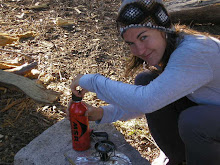Gaucho Land
 The Bolivian-Argentine border at Aguas Blancas, three hours outside of the city of Tarija. No triple fences or snipers in helicopters here. On the way back in we had to go to great lengths to find the immigration office and convince the officer that we did indeed need our passports stamped.
The Bolivian-Argentine border at Aguas Blancas, three hours outside of the city of Tarija. No triple fences or snipers in helicopters here. On the way back in we had to go to great lengths to find the immigration office and convince the officer that we did indeed need our passports stamped. Las madres de la Plaza de Mayo. The mothers of the disappeared who continue to march every Thursday to demand justice for their children.
Las madres de la Plaza de Mayo. The mothers of the disappeared who continue to march every Thursday to demand justice for their children. Riding horses in the countryside outside of Tarija, Bolivia with my friends Nicky and Katja.
Riding horses in the countryside outside of Tarija, Bolivia with my friends Nicky and Katja.At the end of March I hit the road for Buenos Aires to meet up with two friends, Nicky and Chandra, and check out gaucho country. The flight to Tarija in southeastern Bolivia was a quick 45 minutes, the bus from there to BA was 30 hours each way. We saw everything from street art to the Eva Peron Museum, and I saw my first milonga, a performance of the Tango. The tango wasn't always universally loved in Argentina. Tango originally referred to a meeting place where freed and working slaves came together to dance in the early 19th century, and evolved to reflect the changing ethnic composition of porteño (Buenos Aires) society. Tango incorporates African rhythms brought by enslaved Africans (who made up 30% of the porteño population in 1778) and Spanish and Italian melodies introduced by immigrants recruited to replace the indigenous population that was systematically pushed out of Buenos Aires. It is said that indigenous men brought the dance to the slaughter house district of Buenos Aires, where it began to be danced in poor dance houses, bars, and brothels, and where milonga music (fast-paced polka) was incorporated.
We also got to go to a protest (in defense of community art centers the city government was trying to close) and check out the worker-operated Hotel Bauen. Then Nicky and I headed back to Bolivia to meet Katja in Tarija, the sleepy capital city of the department by the same name where much of Bolivia's natural gas is found.


0 Comments:
Post a Comment
<< Home